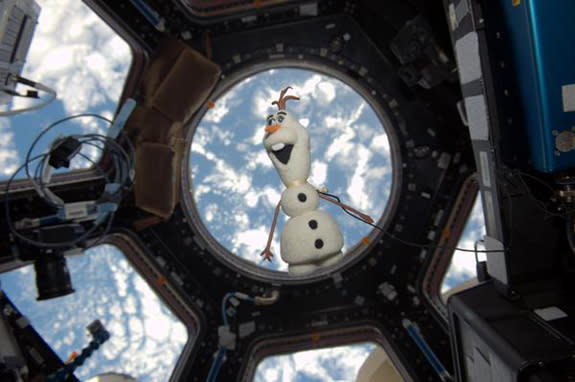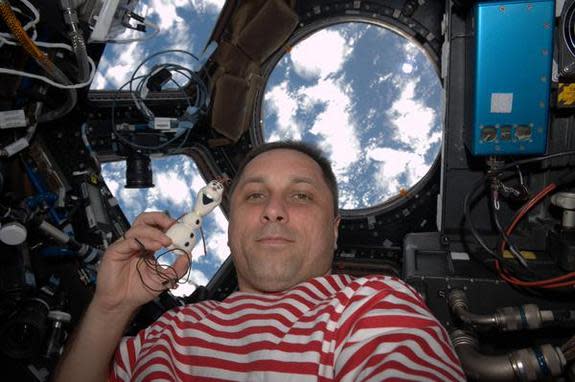'Frozen' in Space! Olaf the Snowman Floats in Zero-G (Photos)
It's one giant leap for snowman-kind: Olaf, the goofy snowman from Disney's hit film "Frozen," is floating aboard the International Space Station, and we have the photos to prove it.
Russian cosmonaut Anton Shkaplerov brought the small, stuffed Olaf toy into space as his mission's "zero-g indicator" at the request of his 8-year-old daughter when he launched on a mission to the International Space Station. Shkaplerov and two crewmates blasted off aboard their Soyuz capsule on Nov. 24 and arrived at the orbiting outpost six hours later. On Tuesday (Dec. 9), Shkaplerov posted a photo on Twitter of Olaf floating serenely in the many-windowed observation deck of the station.
Every Soyuz flight includes a "zero-g" indicator, which is often a toy of some kind selected by the Soyuz commander and crew. The indicator is hung by a string in a place where the crew can see it during launch. (Notice the string tied around Olaf in the images, suggesting Shkaplerov doesn't truly want to "let it go".) When the object becomes weightless and begins to float, it confirms that the crew is in orbit.
Olaf joins a long line of toys in space that have been launched into orbit over the years. Those intrepid toy explorers include Hello Kitty, Legos, Smokey the Bear, a stuffed hippopotamus and a red Angry Bird (which NASA astronaut Don Pettit used to make his own version of Angry Birds in space).
"Frozen" is the highest-grossing animated movie of all time and can truly be said to have reached new heights: 250 miles (402 kilometers) above the Earth, to be exact. The second-highest-grossing animated film of all time, "Toy Story 3," also had a character aboard the station: an action figure of Buzz Lightyear took a ride on NASA's space shuttle Discovery in 2008.
Shkaplerov arrived at the orbiting laboratory on Nov. 24, alongside NASA astronaut Terry Virts and European Space Agency astronaut Samantha Cristoforetti. They join NASA's Barry Wilmore and cosmonauts Alexander Samokutyaev and Elena Serova as part of the Expedition 42 crew. Rotating crews of astronauts have continuously lived aboard the $100 billion International Space Station since 2000.
Follow Calla Cofield @callacofield. Follow us @Spacedotcom, Facebook and Google+. Original article on Space.com.
NASA Launching LEGO Space Shuttle Toy on Real Shuttle Discovery
To the Museum and Beyond! Space-Flown Buzz Lightyear Heads to Smithsonian
Copyright 2014 SPACE.com, a TechMediaNetwork company. All rights reserved. This material may not be published, broadcast, rewritten or redistributed.

 Yahoo News
Yahoo News 

